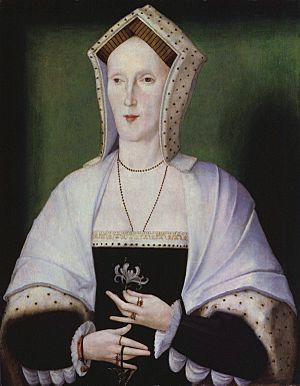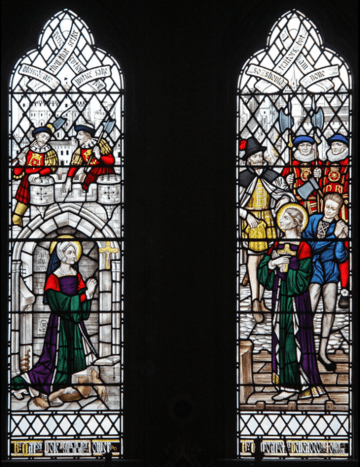Margaret Pole, Countess of Salisbury facts for kids
Quick facts for kids
Margaret Pole
|
|
|---|---|
| Countess of Salisbury Blessed |
|

Portrait of an unknown woman, often identified as the Countess of Salisbury
|
|
| Born | 14 August 1473 Farleigh Hungerford Castle, Somerset, England |
| Died | 27 May 1541 (aged 67) Tower of London, London, England |
| Noble family | York |
| Spouse(s) | Sir Richard Pole |
| Issue | |
| Father | George Plantagenet, 1st Duke of Clarence |
| Mother | Isabel Neville |
| Blessed Margaret Pole |
|
|---|---|
An Icon of Blessed Margaret Pole
|
|
| Martyr | |
| Venerated in | Catholic Church |
| Beatified | 29 December 1886, Saint Peter's Basilica, Papal State by Pope Leo XIII |
| Major shrine | Church of Saint Peter ad Vincula, Tower Hamlets, London, United Kingdom |
| Feast | 28 May (ordinarily, her feast day would coincide with the day of her martyrdom, however 27 May was already in use as the Feast of Saint Augustine of Canterbury) |
| Attributes | Martyr's palm Rosary Tunic bearing the Five Wounds of Christ |
Margaret Pole, Countess of Salisbury (born August 14, 1473 – died May 27, 1541) was an important English noblewoman. She was the only daughter of George Plantagenet, Duke of Clarence. George was the brother of Kings Edward IV and Richard III.
Margaret was one of the few women in 16th-century England to hold a noble title on her own. She was also one of the last members of the House of Plantagenet royal family to survive the Wars of the Roses. King Henry VIII ordered her execution in 1541. He was the son of her first cousin, Elizabeth of York. Later, Pope Leo XIII declared her a saint in the Roman Catholic Church on December 29, 1886. She is known as "Blessed Margaret Pole."
Contents
Early Life and Family
Margaret was born at Farleigh Hungerford Castle in Somerset, England. Her parents were George Plantagenet, Duke of Clarence, and Isabel Neville. Isabel was the daughter of Richard Neville, 16th Earl of Warwick, a powerful nobleman.
Margaret's mother died when Margaret was only three years old. Her father, the Duke of Clarence, was later accused of treason. In 1478, he was executed, and his lands and titles were taken away.
Growing Up in a Royal Family
When Margaret was ten, King Edward IV died. Her uncle, Richard, Duke of Gloucester, became king. He sent Margaret and her younger brother, Edward, to Sheriff Hutton Castle.
In 1485, Richard III was defeated and killed in battle. Henry Tudor became the new king. He married Margaret's cousin, Elizabeth of York. Margaret and her brother were then cared for by the new royal family.
Margaret's brother, Edward, was a potential threat to the new king. This was because Edward was a male heir from the old royal family. So, Edward was moved to the Tower of London.
Marriage and Hardship
Around 1487, King Henry VII arranged for Margaret to marry his cousin, Sir Richard Pole. Sir Richard held several important jobs for the king.
Margaret became a lady-in-waiting to Catherine of Aragon. Catherine later married Henry VIII. But Margaret's life changed when her husband, Sir Richard, died in 1505. She was left with five children and little money.
To help her family, Margaret sent her third son, Reginald Pole, to study for the Church. She also lived at Syon Abbey with nuns for a time. Her situation improved when Henry VIII became king in 1509.
Countess of Salisbury Title
In 1509, Henry VIII married Catherine of Aragon. Margaret was again appointed as one of Catherine's ladies-in-waiting. In 1512, a special law was passed. This law gave Margaret back her family title, Countess of Salisbury. She also got back some of her family's lands.
Managing Her Estates
As Countess of Salisbury, Margaret was very good at managing her lands. By 1538, she was one of the richest nobles in England. She also supported new ideas and learning, like many noblewomen of her time.
Her eldest son, Henry Pole, became a baron. Her second son, Arthur Pole, worked at the royal court. Her third son, Reginald Pole, studied abroad and became an important church leader. Her youngest son, Geoffrey Pole, also married well. Her daughter, Ursula, married a nobleman.
Margaret's standing at court changed over time. She had a disagreement with Henry VIII about land in 1518. In 1520, she became the governess for Henry's daughter, Princess Mary. She was removed from this role for a short time but was back by 1525.
Loyalty to Princess Mary
When Princess Mary was declared illegitimate in 1533, Margaret refused to give Mary's valuable items back to King Henry. Mary's household was later broken up. Margaret offered to serve Mary at her own expense, but the king did not allow it.
The Fall of Margaret Pole
Margaret's troubles began because of her son, Reginald Pole. In 1531, Reginald warned against King Henry VIII's marriage to Anne Boleyn. He also disagreed with Henry's decision to become the head of the Church in England.
Reginald wrote a pamphlet that criticized Henry's actions. He even urged other European leaders to remove Henry from power. Henry was very angry about this. He wrote to Margaret, asking her to scold her son.
Arrests and Accusations
In 1537, Reginald became a Cardinal in the Catholic Church. He tried to organize support against Henry VIII's religious changes. This made Henry even more determined to stop him and his family.
In 1538, Margaret's son, Geoffrey Pole, was arrested. He had been writing to Reginald. Under questioning, Geoffrey said that his older brother, Lord Montagu, and another nobleman were also involved.
In November 1538, Margaret, her son Henry (Lord Montagu), and others were arrested. In January 1539, Geoffrey was pardoned. But Margaret's son Henry and his cousin were later executed for treason.
Loss of Titles and Lands
In May 1539, Margaret and her family members were stripped of their titles and lands. This was done through a special law called an "attainder." This meant they lost everything they owned.
As part of the evidence against her, a tunic with symbols of Catholicism was supposedly found in her house. This was likely made up, as it was found months after her arrest. Margaret was sentenced to death, and the king could order her execution at any time.
Margaret Pole was held in the Tower of London for two and a half years. She was supported by the king and had servants. In 1540, Thomas Cromwell, who had been a key figure in her arrest, fell from power and was executed himself.
Execution

A poem was found carved on the wall of her prison cell:
For traitors on the block should die;
I am no traitor, no, not I!
My faithfulness stands fast and so,
Towards the block I shall not go!
Nor make one step, as you shall see;
Christ in Thy Mercy, save Thou me!
On the morning of May 27, 1541, Margaret was told she would die within the hour. She said she had not committed any crime. She was taken from her cell to a low wooden block inside the Tower of London.
Two people who saw her execution wrote about it. One was the French ambassador, and the other was the ambassador to the Holy Roman Emperor. Their accounts are slightly different. Margaret was buried in the chapel of St Peter ad Vincula within the Tower of London.
Her son, Reginald Pole, later said he was proud to be "the son of a martyr." The Catholic Church recognized her as a martyr. She was declared "Blessed" on December 29, 1886, by Pope Leo XIII.
Margaret's Children
Margaret and her husband, Sir Richard Pole, had five children:
- Henry Pole, 1st Baron Montagu (about 1492–1539): He was involved in the trial of Anne Boleyn. He had four children and was executed by Henry VIII.
- Arthur Pole (before 1499–before 1532): He was a landowner in Sussex and had four children.
- Reginald Pole (about 1500–1558): He became a cardinal and was the last Catholic Archbishop of Canterbury.
- Geoffrey Pole (about 1501–1558): He was suspected of treason by King Henry VIII. He later lived in exile in Europe and had children.
- Ursula Pole (about 1504–1570): She married Henry Stafford, 1st Baron Stafford, and they had about fourteen children.
Margaret Pole in Culture
Margaret Pole has been shown in many plays, TV shows, and books:
- She appears in William Shakespeare's play Richard III.
- The character of Lady Salisbury in the TV series The Tudors is based on her.
- Janet Henfrey played Margaret in the 2015 BBC series Wolf Hall.
- Margaret is the main character in Philippa Gregory's 2014 novel The King's Curse. She also appears in Gregory's other novels, The Kingmaker's Daughter and The White Princess.
- Rebecca Benson played her in the TV show The White Princess. Laura Carmichael played her in The Spanish Princess.
- She is the main character in Samantha Wilcoxson's 2016 novel, Faithful Traitor.
|
See also
 In Spanish: Margarita Pole para niños
In Spanish: Margarita Pole para niños


